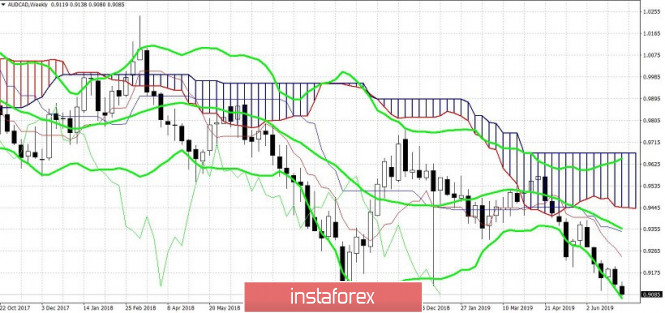Dollar pairs are waiting for the main event of the day - the speech of Fed Chairman Jerome Powell in Congress. Yesterday he spoke at the opening of the banking conference organized by the Federal Reserve Bank of Boston (via video conference), but his speech was ceremonial, without mentioning the prospects for monetary policy. But today the situation is radically different. Powell will not only give a report on the immediate prospects for monetary policy, but also answer questions from congressmen who are also interested in the fate of the interest rate.
Considering the importance of this event, it is better not to trade in dollar pairs - at least until such time as Powell's position is clear in the light of the latest data on the US labor market. The greenback can stop its growth and weaken across the market if the Fed chief confirms the regulator's intention to lower the rate this month. Vice versa - the US currency will continue its rally if it eliminates these concerns. There is no consensus among analysts as to exactly which scenario is being implemented. Therefore, in the light of the continuing intrigue, it is better to temporarily leave the dollar alone - its fate is too uncertain.

But you should take a look at some cross pairs. My personal favorite among the other crosses is the pound-yen pair. Playing against the British currency is almost a win-win tactic, especially amid growing confidence regarding the implementation of a "hard" Brexit. But lately, the volatility of the pair has decreased: the pound in anticipation of Johnson's appointment and his first decisions as a prime minister, the yen in anticipation of the next geopolitical upheaval, of which it is the beneficiary. In terms of relative silence, the GBP/JPY cross pair demonstrates low activity, and therefore is of little interest to traders.
In turn, the AUD/CAD cross pair has recently shown increased volatility - over the past three months, the pair has fallen by more than 500 points and continues to show a downward movement. Today, the downward trend can get another impulse, according to the results of the July meeting of the Bank of Canada. If Stephen Poloz doesn't surprise traders with a soft rhetoric, the bearish mood on the pair will increase significantly, especially against the background of the announced intentions of the RBA.
In general, the downward trend in AUD/CAD is primarily due to the decoupling of the actions of the RBA and the Bank of Canada. The Australian regulator has already reduced the interest rate twice this year, and apparently it is not going to stop there. At the last meeting, members of the regulator hinted rather transparently at the "continuation of the banquet" if the key parameters of the Australian economy do not show signs of growth. Since the July meeting (which took place on the 2nd of March), only minor macroeconomic releases have been published - but they have also disappointed investors. For example, the index of business confidence, which is calculated by the largest bank in Australia NAB, showed a negative trend, dropping to 2 points. Westpac, the other largest bank in the country, published the consumer confidence index yesterday, which also showed a downward trend. This indicator has updated two-year lows, reflecting the uncertainty of Australians in their financial well-being.
Chinese data is also controversial. The PRC consumer price index published today remained at the level of May (2.7%), while the producer price index was worse than expected, dropping to zero (the weakest growth rate in three years). The Australian dollar is quite sensitive to indicators of the dynamics of the Chinese economy, so the AUD/CAD cross pair continues to show a bearish attitude today.
The Canadian dollar against the background of the aussie looks confident, even despite the very contradictory data on the labor market in Canada, which were published last week. Canadians have a significant trump card - strong inflation - whose growth dynamics surpassed all expectations. In addition, the warming of relations between Ottawa and Washington, as well as the growth of the oil market, make it possible for the Bank of Canada to remain on hold. Moreover, some of the analysts are expecting "hawkish" notes in rhetoric from Steven Poloz today - although in my opinion, the head of the regulator will limit himself to cautious optimism. However, this is quite enough to continue the downward trend of the AUD/CAD pair.
From a technical point of view, the cross pair is under significant pressure and as well as on all the higher time frames. On H4, D1, W1 and MN, the pair is on the lower line of the Bollinger Bands indicator, which also indicates the priority of a downward movement. The pair shows a pronounced bearish trend, as evidenced by the main trend indicators - Bollinger Bands and Ichimoku Kinko Hyo. Thus, the Ichimoku Kinko Hyo indicator on the daily chart formed its strongest bearish signal, "Parade of Lines," in which all lines of the indicator are above the price chart, thereby showing pressure on the pair.

In turn, the price is on the lower line of the Bollinger Bands indicator, which shows a narrowed channel - this is also a strong signal for a downward direction. An additional confirmation to the bearish scenario is the oversoldness of the MACD and Stochastic oscillators. In order to determine the main goal of the downward movement, let's move to the weekly timeframe: here we focus on the lower line of the Bollinger Bands - this is the price of 0.9050. Strong arguments are necessary in order for the pair's bears to go below this mark - not only at the expense of a weak aussie, but also at the expense of a strong loonie. Today's meeting of the Canadian regulator can play a significant role in this.
The material has been provided by InstaForex Company - www.instaforex.com